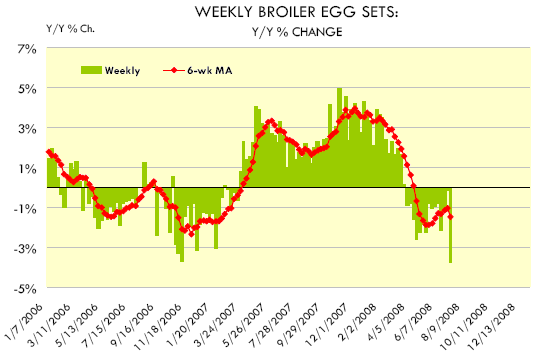



CME: Current Broiler Market Dynamics
US - CME's Daily Livestock Report for 9 July, 2008.USDA released on Wednesday afternoon its weekly broiler hatchery report and its results deserve some attention.
The report revised lower some of the previous estimates regarding the number of egg sets and chick placements during June and in the first week of July. For the week ending July 5, total eggs set in incubators were estimated at 207,941, 3.7% lower than a year ago. Chick placements for the week were 174,510, 2.1% lower than a year ago. Egg sets and chick placements have declined notably in the last three months but there continue to be questions about the ability of the industry to sustain a prolonged reduction in broiler supplies.
While broiler egg sets for the past eight weeks or so have been lower than a year ago, the reductions were less than many expected in light of sharply higher corn and soybean meal costs.
| E-Livestock Volume | 9-Jul | 8-Jul | 2-Jul |
|---|---|---|---|
| LE (E-Live Cattle): | 15,500 | 20,184 | 9,741 |
| GF (E-Feeder Cattle): | 1,543 | 1681** | 617 |
| HE (E-Lean Hogs): | 17,182 | 15,900 | 10,609 |
| ** Record Globex Volume | |||
A closer look at the USDA data, however, provides a glimpse of the current dynamics in the broiler market. Some of the large broiler-producing states - where the largest broiler companies have located many of their operations - show significant declines from a year ago. For the last six weeks, egg sets in Arkansas and Georgia, two of the top three broiler-producing states, have declined 5.9% and 5.5%, respectively. This is in line with statements from executives of some of the big broiler companies.
On the other hand, eggs set in Alabama, another big broiler producing state, are just 0.5% lower than a year ago. While overall egg sets are down in most of the major broiler-producing states, some smaller states actually show notable increases from a year ago - an indication that even in these difficult economic times, smaller producers are trying to gain ground against competitors.
This is not new: in the past, broiler production never fell as much as many expected for precisely that reason - smaller producers picked up the slack when the bigger players cut back.
This year is somewhat different, however, with large producers facing increasing cost pressures given $7-8 corn and $400 meal prices. Also, their inability to this point to put more money on breast meat will further hamper their profitability.
Exports and higher dark meat prices have helped considerably but unless prices in the domestic market increase (i.e. breast meat prices) the industry will have to cut back some more.









